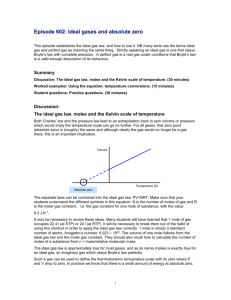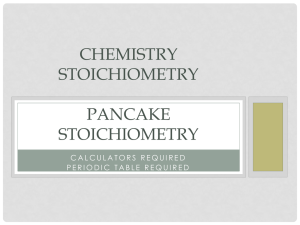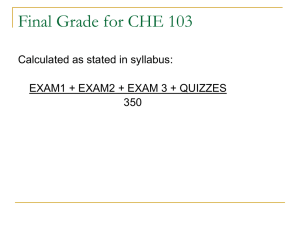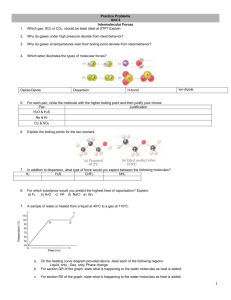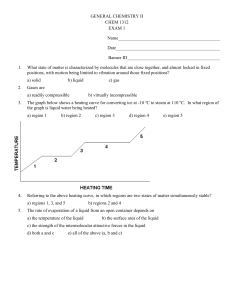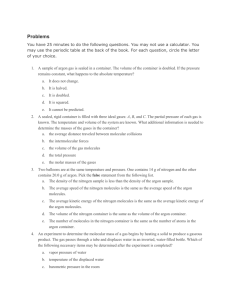AP Chemistry: Gases & Intermolecular Forces Problem Set
advertisement
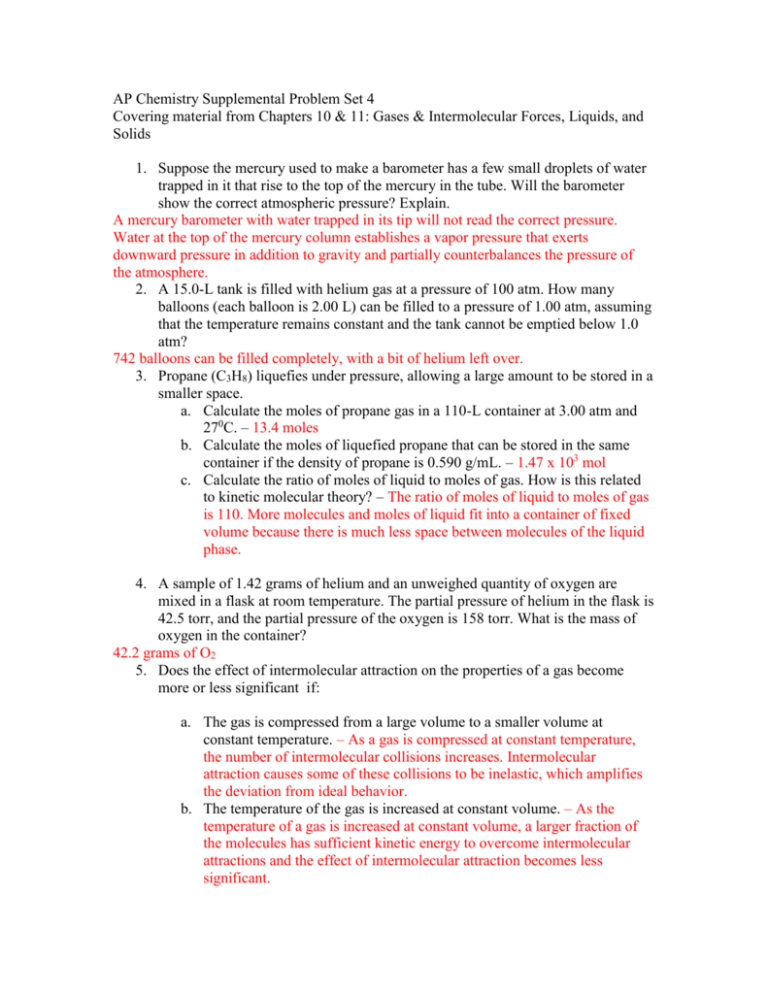
AP Chemistry Supplemental Problem Set 4 Covering material from Chapters 10 & 11: Gases & Intermolecular Forces, Liquids, and Solids 1. Suppose the mercury used to make a barometer has a few small droplets of water trapped in it that rise to the top of the mercury in the tube. Will the barometer show the correct atmospheric pressure? Explain. A mercury barometer with water trapped in its tip will not read the correct pressure. Water at the top of the mercury column establishes a vapor pressure that exerts downward pressure in addition to gravity and partially counterbalances the pressure of the atmosphere. 2. A 15.0-L tank is filled with helium gas at a pressure of 100 atm. How many balloons (each balloon is 2.00 L) can be filled to a pressure of 1.00 atm, assuming that the temperature remains constant and the tank cannot be emptied below 1.0 atm? 742 balloons can be filled completely, with a bit of helium left over. 3. Propane (C3H8) liquefies under pressure, allowing a large amount to be stored in a smaller space. a. Calculate the moles of propane gas in a 110-L container at 3.00 atm and 270C. – 13.4 moles b. Calculate the moles of liquefied propane that can be stored in the same container if the density of propane is 0.590 g/mL. – 1.47 x 103 mol c. Calculate the ratio of moles of liquid to moles of gas. How is this related to kinetic molecular theory? – The ratio of moles of liquid to moles of gas is 110. More molecules and moles of liquid fit into a container of fixed volume because there is much less space between molecules of the liquid phase. 4. A sample of 1.42 grams of helium and an unweighed quantity of oxygen are mixed in a flask at room temperature. The partial pressure of helium in the flask is 42.5 torr, and the partial pressure of the oxygen is 158 torr. What is the mass of oxygen in the container? 42.2 grams of O2 5. Does the effect of intermolecular attraction on the properties of a gas become more or less significant if: a. The gas is compressed from a large volume to a smaller volume at constant temperature. – As a gas is compressed at constant temperature, the number of intermolecular collisions increases. Intermolecular attraction causes some of these collisions to be inelastic, which amplifies the deviation from ideal behavior. b. The temperature of the gas is increased at constant volume. – As the temperature of a gas is increased at constant volume, a larger fraction of the molecules has sufficient kinetic energy to overcome intermolecular attractions and the effect of intermolecular attraction becomes less significant. 6. Fill in the blanks in the following chart: Pressure Volume Moles Temperature 760 torr 24.4 L 0.998 moles 250C 125 kPa 9.98 Liters 0.500 mol 300 K 4970 mm Hg 2.59 L 0.750 mol 275 K 1.25 atm 450 mL 0.250 mol -246 0C 7. Using the Van der Waals equation, calculate the pressure of a gas that occupies 2.59 L, 0.750 mol, and 275 K if the gas is: a. Krypton – a = 2.32 L2-atm/mol2 & b = 0.0398 L/mol – 6.42 atm b. Carbon dioxide – a = 3.59 L2-atm/mol2 & b = 0.0427 L/mol – 6.30 atm 8. As the intermolecular attractive forces between molecules increase, how do you expect the following values to change? a. Vapor pressure – decrease b. Heat of vaporization – increase c. Boiling point – increase d. Freezing point – decrease e. Viscosity – increase f. Surface tension – increase g. Critical temperature – increase 9. Explain the order of boiling points for the following derivatives of benzene: a. Benzene, mp=800C b. Chlorobenzene, mp=1320C c. Bromobenzene, mp=1560C d. Phenol, mp=1820C (hydroxyl benzene) When a halogen is substituted for H in benzene, molar mass, polarizability and strength of dispersion forces increase; the order of increasing molar mass is the order of increasing boiling points for the first three compounds. Phenol experiences hydrogen bonding, the strongest force between neutral molecules, so it has the highest boiling point. 10. The following table corresponds to hexafluorobenzene (C6F6) Temperature (K) 280.0 300.0 320.0 330.0 340.0 Vapor Pressure (torr) 32.42 92.47 225.1 334.4 482.9 Plot the data and determine whether the Clausius-Clapeyron equation is obeyed. If it is, use the equation to calculate ΔHvap for hexafluorobenzene. Then use the data to determine the boiling point for the compound. y = -4288.1x + 18.806 R2 = 0.9999 Problem Set #10 ln Pressure (torr) 7 6 5 4 3 2 1 0 0.002 0.0025 0.003 0.0035 0.004 1/Temperature (K) ΔHvap = -m x R = -(-4288.1) x (8.314 J/mol – K) = 35.7 kJ/mol Ln(760) = -4288.1 (1/T) + 18.806 T = 352 K = 790C 11. Explain why X-rays can be used to measure atomic distances in crystals, but visible light cannot. Why can’t NaCl have the same crystal structure as CaCl2? Diffraction, the phenomenon that enables us to measure interatomic distances in crystals, is more efficient when the wavelength of light is similar to or smaller than the size of the object doing the diffracting. Atom sizes are on the order of 1 – 10 Ả, and the wavelengths of x-rays are also in this range. Visible light, 400 – 700 nm or 4000 – 7000 Ả, is too long to be diffracted effectively by atoms (electrons) in crystals. 12. Use the table below to describe (in terms of intermolecular interactions) how molar heat of vaporization changes with: a. Molar mass b. Molecular shape c. Molecular polarity d. Hydrogen bonding interactions Compound (i) CH3CH2CH3 (ii) CH3CH2CH2CH2CH3 (iii) CH3CHBrCH3 (iv) CH3C=OCH3 (v) CH3CH2CH2Br (vi) CH3CH2CH2OH Heat of vaporization 19.0 27.6 31.8 32.0 33.6 47.3 Molar mass – Compounds (i) and (ii) have similar rodlike structures. The longer chain in (ii) leads to greater molar mass, stronger LDF, and higher heat of vaporization Molecular shape – compounds (iii) and (v) have the same chemical formula and molar mass, but different molecular shapes. The more rodlike shape of (v) leads to more contact between molecules, stronger dispersion forces, and higher heat of vaporization. Molecular polarity – Compound (iv) has a smaller molar mass than (ii) but a larger heat of vaporization, which must be due to the presence of dipole-dipole forces. Hydrogen Bonding Interactions – Molecules (v) and (vi) have similar structures. Even though (v) has a larger molar mass and dispersion forces, hydrogen bonding causes (vi) to have higher heat of vaporization.





